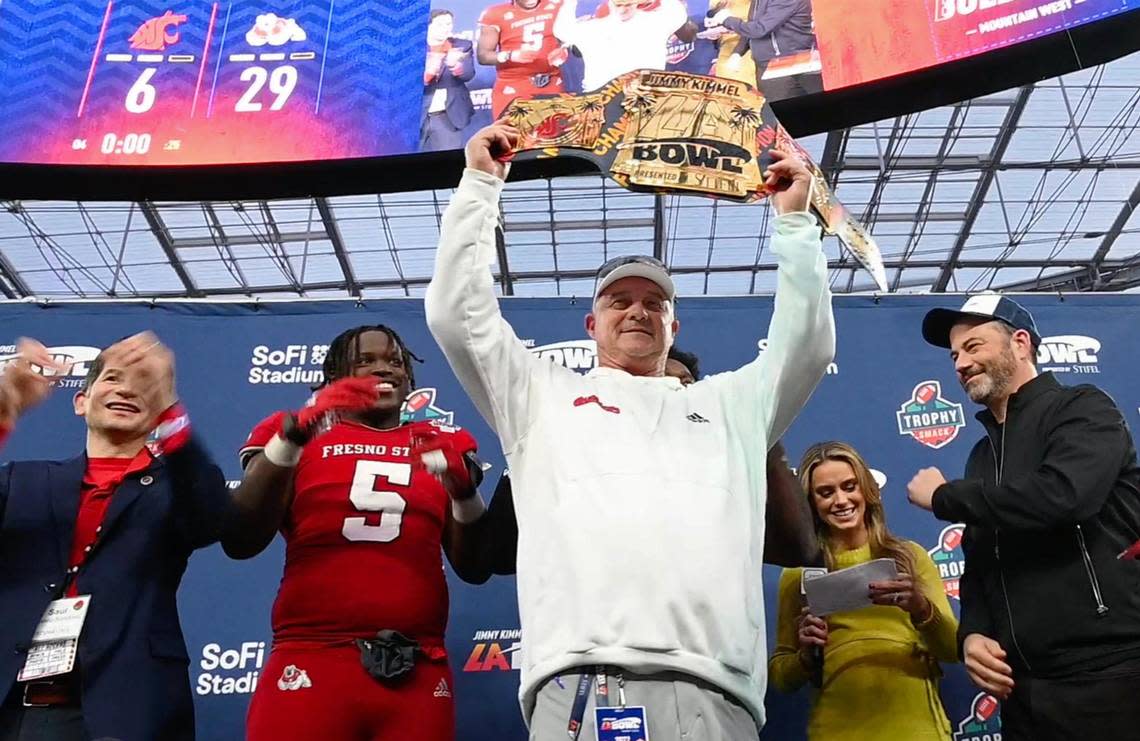Fresno State is well-positioned for next conference shakeup following Pac-12’s collapse | Opinion

The conference that has long excluded Fresno State and other West Coast universities that don’t meet its lofty standards is effectively toast.
Which finally gives me an answer for all those times I’ve been asked whether the Bulldogs had any chance of being in the Pac-12.
“Absolutely,” I can say now, with absolute and total certainty. “Provided USC, UCLA, Oregon and Washington first join the Big Ten and Arizona, Arizona State, Utah and Colorado bolt for the Big 12. Then it could happen.”
Two years ago, such a scenario would’ve been unimaginable. Yet here we are. More than a century of history, tradition and hubris evaporated in a few frantic, uncertain hours over a video conference call.
While Fresno State wasn’t directly impacted by the latest seismic shift in college athletics, the Bulldogs will certainly feel its aftershocks. Things could shake out several ways, and the unpredictability that comes with that is what keeps college presidents and athletic directors up at night.
Opinion
What happens next hinges on a number of factors dictated by conference bylaws and existing TV contracts. Will the remaining Pac-12 teams stick together and keep the league going by inviting new members to backfill those that left? If so, who gets those invites, and how many go out?
There were reports Tuesday that San Diego State president Adela de la Torre led a push to form a new conference made up of top schools from the Mountain West and American Athletic Conference along with some combination of the Pac-12 leftovers. That effort apparently died when the MW presidents pledged unity to one another during a Monday night conference call.
San Diego State AD John David Wicker called the reports “FAKE NEWS” on Twitter, a choice of words that probably vouches for its accuracy.
Meanwhile, Stanford and Cal are also under consideration by the ACC, which stands for Atlantic Coast Conference. (Yes, geography and proximity have long been tossed out the window.) If that happens, then Oregon State and Washington State will have little choice but to link up with the MW in some form or another.
The reformulated league, for marketing and media rights purposes, could even retain the Pac-12 name. Which would feel like a hollow achievement for universities such as Fresno State that have yearned to be part of that conference and were always barred at the gate.
Big 12 hopes all but dead
I’m not ignoring the fact that, for the last year or so, Bulldogs fans and boosters have been abuzz about the Big 12. While there have indeed been conversations between school officials and Big 12 Commissioner Brett Yormark, my sense is that Fresno State was always a longshot in that derby.
Those hopes can now all but be put to bed. If the Big 12 decides to further expand beyond its four recent Pac-12 additions, it’s hard to see Fresno State any higher than the fourth or fifth choice as things currently stand.
Sorry if that hurts any Red Wave feelings. I’d love nothing more than to be proven wrong.
The Pac-12’s demise, when viewed through a central San Joaquin Valley lens, actually comes at a fairly opportune time. If only because the Bulldogs are well positioned for the repercussions.
Fortunately for Fresno State, conference contraction (a better descriptor than “realignment”) is all about football. Other sports don’t really matter in this network television-controlled landscape, which helps explain why Stanford and Cal, academic powerhouses that also produce the most Olympic athletes and US women’s national team soccer players, are in desperation mode.
By contrast, Bulldogs football is humming. The program is fresh off a MW championship, produced back-to-back 10-win seasons and led by one of the sport’s most respected offensive minds in Jeff Tedford. Who, unlike most successful Group of Five head coaches, isn’t chasing a bigger job.
Strong attendance, leadership
At a time when college football attendance is shrinking nationwide, Fresno State stands out as an exception. The Bulldogs drew an average of 39,067 fans last season, which represented a 28% uptick over five years before and trailed only USC and UCLA among California schools.
Facilities are one area where Fresno State has lagged. But at least now Athletic Director Terry Tumey and his fundraising team have a well-crafted plan to remedy that, starting with a much-needed makeover of Valley Children’s Stadium.
Fresno State is far better off to withstand conference contraction today than it was six or seven years ago during the listless final seasons of Tim DeRuyter’s tenure. Or in the late 2000s when things stagnated under Pat Hill and the Bulldogs were hamstrung by a disinterested president and out of touch athletic director.
That certainly isn’t the case today. Tumey and President Saúl Jiménez-Sandoval are involved, proactive leaders at a time when upper-level university administrators and the athletic department appear to be in alignment instead of working at cross purposes.
I can’t predict what the West Coast college athletics landscape will look like following the latest round of musical chairs. However, there aren’t many realistic scenarios where Fresno State ends up without a seat or one at a worse table when the music stops.
In the dog-eat-dog world of college athletics at the FBS level, where tradition, geographic rivalries and ease of travel for student-athletes and fans count for zilch, that in itself should be considered a win.

